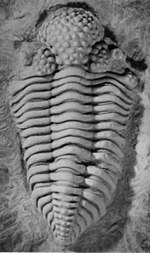Gorstian
Silurian graphical timeline | ||||||||
−444 — – −442 — – −440 — – −438 — – −436 — – −434 — – −432 — – −430 — – −428 — – −426 — – −424 — – −422 — – −420 — – −418 — |
| |||||||
In the geologic timescale, the Gorstian is the age of the Ludlow epoch of the Silurian period of the Paleozoic era of the Phanerozoic eon that is comprehended between 427.4 ± 0.5 Ma and 425.6 ± 0.9 Ma (million years ago), approximately. The Gorstian age succeeds the Homerian age and precedes the Ludfordian age.[4] The age is named after Gorsty village southwest of Ludlow. The base of the age is marked by Graptolites tumescens and Graptolites incipiens. The type section is located in a quarry in the Elton Formation at Pitch Coppice, Shropshire, United Kingdom.[5]
Palaeontology
Arthropods
| Arthropods of the Gorstian | ||||
|---|---|---|---|---|
| Taxa | Presence | Location | Description | Images |
| Brontoscorpio | Trimpley, Worcestershire, UK | |||
| Balizoma | 440.8 million years ago to Pridoli epoch | Dudley, England | The genus has only been found in rocks of Silurian age. |  |
References
- ^ Jeppsson, L.; Calner, M. (2007). "The Silurian Mulde Event and a scenario for secundo—secundo events". Earth and Environmental Science Transactions of the Royal Society of Edinburgh. 93 (02): 135–154. doi:10.1017/S0263593300000377.
- ^ Munnecke, A.; Samtleben, C.; Bickert, T. (2003). "The Ireviken Event in the lower Silurian of Gotland, Sweden-relation to similar Palaeozoic and Proterozoic events". Palaeogeography, Palaeoclimatology, Palaeoecology. 195 (1): 99–124. doi:10.1016/S0031-0182(03)00304-3.
- ^ "Chart/Time Scale". www.stratigraphy.org. International Commission on Stratigraphy.
- ^ Gradstein, Felix M.; Ogg, James G.; Smith, Alan G. (2004). A Geologic Time Scale 2004. ISBN 9780521786737.
- ^ Silurian System
